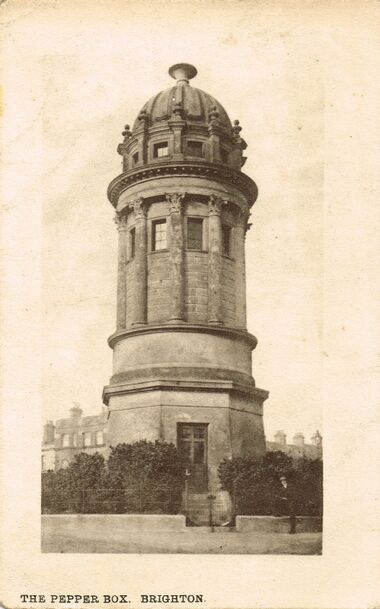Pepper Pot
Brighton Statues and Landmarks -0.12481452036229283 coordinates: 50.82729130509213, -0.12481452036229283
Postcard: "The Pepper Box" [image info]
The Pepper Pot (or Pepper Box) is an italianate circular domed tower designed by Charles Barry as part of an 1828 commission from Thomas Attree, owner of what became Queens Park. The tower was at one corner of the grounds of Attree's Villa, which has since been demolished.
Purpose
Although the multple purposes the tower has been put to over the years have clouded the issue of the building's original purpose, an 1834 architectural journal states that the tower was built to house a steam engine and observatory, and its proximity to Attree Villa (as was) and position over an old well lends credence to suggestions that it held a water tank, which was topped up from the well by the steam engine, and which then fed Attree Villa with water by gravity (in other words ... a water tower).
It may also be relevant that if we follow the downhill slope from the Pot, we tend to end up end the Queens Park drinking fountain, downhill of which, an artificial stream then leads to the lake in Queens Park. So perhaps the Pepper Pot might also have been intended to work as the water source for the Park's lake, drinking fountain and water feature.
At various times, the tower has housed a printing press (Tower Press), and been a public toilet, a wartime lookout tower, and an artist's studio.
1834 description:
Art. VI On the Uses of Concrete as artificial Stone.
By G. L. SYMES, Esq.
I BELIEVE NO one has brought this useful material to so great a degree of perfection as, and used it more generally than, Mr. William Ranger, formerly of Brighton, but now residing at Westminister.
Mr. Ranger conceived that concrete was not sufficiently understood to be duly appreciated; he therefore turned his attention to the matter, and, after considerable time expended in study and experimentalising, he, in 1832, took out a patent for preparing a kind of artificial stone. This artificial stone is formed in principle precisely the same as concrete, but with more care and cleanliness.
The first work executed in this new material was a wall surrounding the garden of Mr. Peel of Kemp Town. The ashlar stones (2 ft. long and 9 in. by 8 in.) were formed on the spot, and became, in a few hours, sufficiently hard to commence setting. The mortar used in laying was formed of the same materials, and the whole became, as it were, one entire mass of concrete; having the precise appearance and the durability of Portland stone, though the proprietor did not incur above a third of the expense.
A beautiful edifice, called Belvedere Tower, was next commenced by Mr. Ranger. This building, built for the purpose of enclosing a steam-engine, is from a design from the pencil of Mr. Barry, and consists of an octagonal pedestal, upon which is placed another of a circular form, supporting eight three-quarter columns of the Corinthian order, with it very neat and elegant Capital, cornice, &c. Over these are placed pilasters, or antae, finishing with a raised-paneled dome; and a handsome finial, constituting the chimney, completes the structure. The whole of this tower, with the exception of the octagonal pedestal, is built with this valuable material, and reflects great credit both on the architect and the builder. The tower, which answers the double purpose of engine-house and observatory, is situated on a delightful prominence in Brighton Park, the property of Thomas Attree, Esq. Two gateways to this park have also been designed by Mr. Barry, and erected of this patent stone. The southern gate is one of the most beautiful of which the County can boast.
— , G. L. Symes Loudon's Architectural Magazine and Journal of Improvement in Architecture, Building, and Furnishing, and in the Various Arts and Trades Connected Therewith · Volume 2 (1935), , 1835



